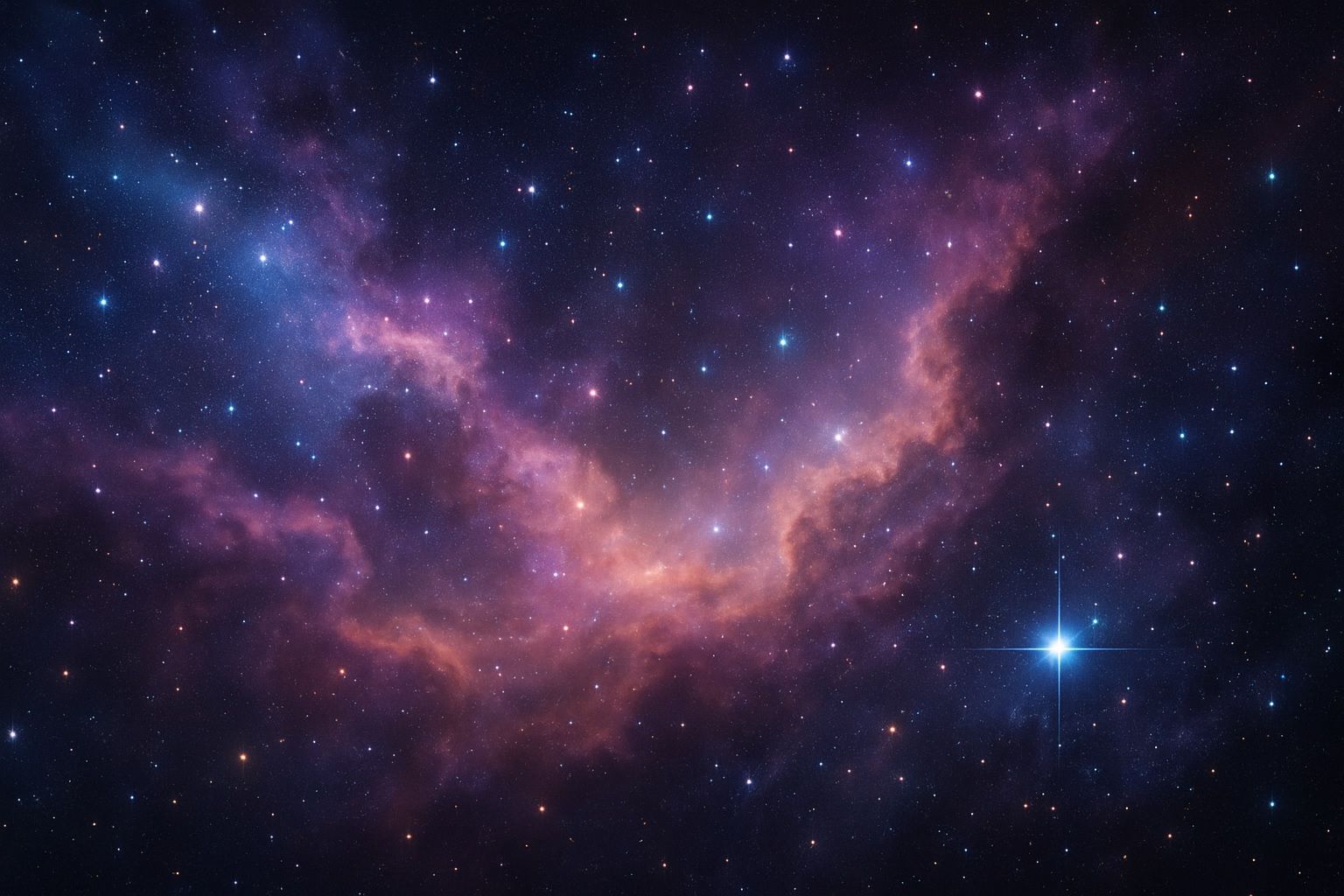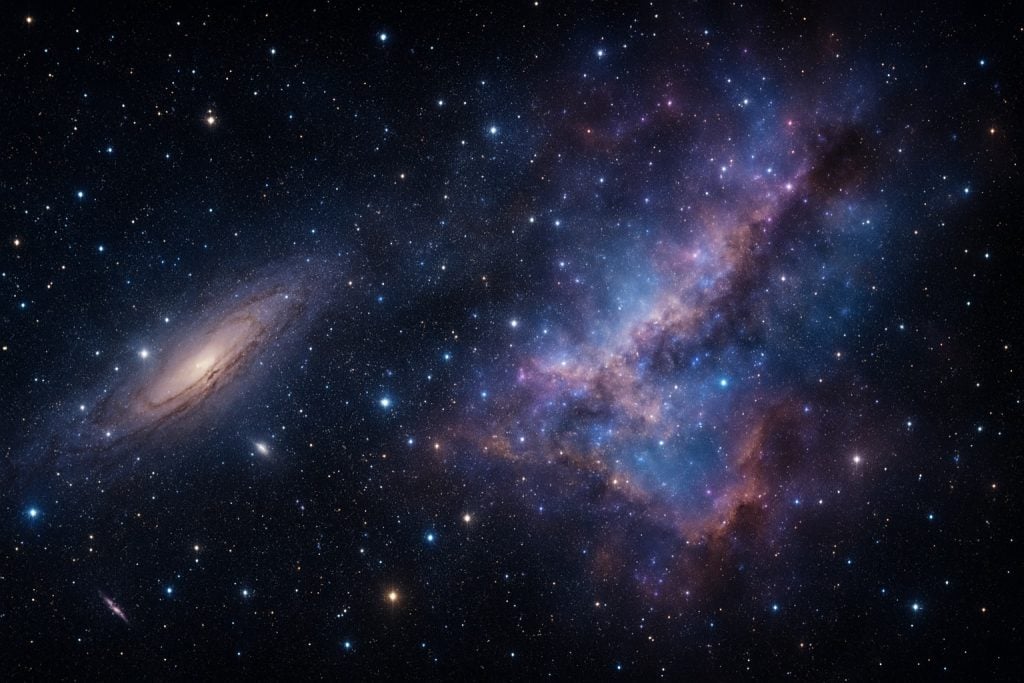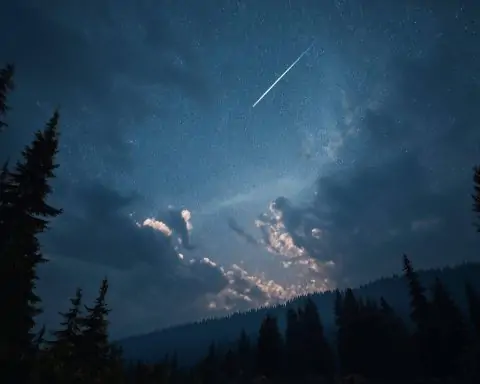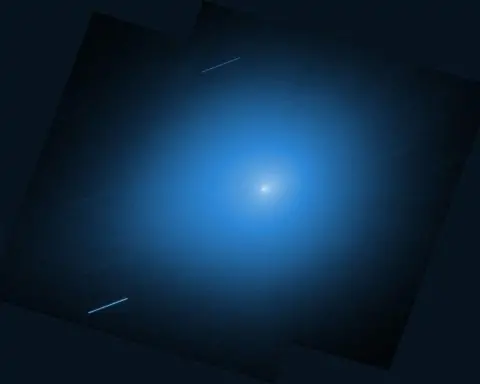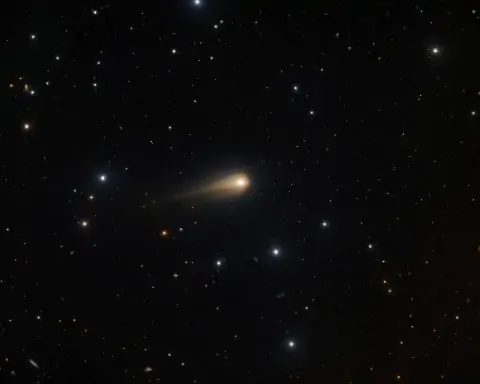- JWST launched on December 25, 2021, aboard an ESA Ariane 5 rocket to the Sun-Earth L2 point, reaching about 1.5 million kilometers from Earth in January 2022.
- Its 6.5-meter segmented gold-coated beryllium primary mirror consists of 18 hexagonal segments, each about 1.32 meters across and roughly 20 kilograms, designed to fold for launch.
- JWST uses a five-layer Kapton sunshield measuring roughly 21 by 14 meters to keep the optics around 40 kelvin, while the MIRI instrument operates at about 7 kelvin with a dedicated cryocooler.
- JWST carries four main instruments: NIRCam (0.6-5 μm; 4-megapixel arrays and wavefront sensing), NIRSpec (0.6-5 μm with a microshutter array for 100+ objects), MIRI (5-28.5 μm with a cryocooler), and FGS/NIRISS (0.8-5 μm; fine guidance and exoplanet modes).
- Within weeks of starting science operations, JWST detected water vapor in the atmosphere of the exoplanet WASP-96 b.
- JWST achieved the first robust detection of carbon dioxide in an exoplanet atmosphere in WASP-39 b, via a 4.3 μm absorption feature.
- In 2023 JWST studied K2-18 b, a sub-Neptune in its star’s habitable zone, finding methane and carbon dioxide and hints of dimethyl sulfide.
- JWST produced high-resolution views of the TRAPPIST-1 system and conducted transit spectroscopy on some of its Earth-sized planets.
- JWST identified galaxies at redshifts z approximately 12-14, corresponding to about 300-400 million years after the Big Bang, with the SMACS 0723 deep field revealing thousands of distant galaxies.
- Spectroscopy with JWST confirmed galaxies at redshifts z ≈ 11-13 and detected heavy elements in galaxies less than 1 billion years old, while many high-redshift galaxies show signs of massive black holes already in place.
The James Webb Space Telescope (JWST) is the largest, most powerful and most complex space telescope ever launched [1]. A joint mission of NASA, ESA, and CSA, JWST serves as a “cosmic time machine” for modern astronomy by using infrared vision to peer back over 13.5 billion years and reveal the earliest stars and galaxies [2] [3]. With a 6.5-meter gold-coated mirror and ultra-sensitive instruments, JWST can detect objects too distant, faint, or ancient for its predecessor, the Hubble Space Telescope [4]. This enables investigations across every phase of cosmic history – from the first luminous glows after the Big Bang, through the formation of galaxies, stars, and planets, and even to the evolution of our own solar system [5]. The telescope’s unprecedented capabilities have already begun to revolutionize astronomy, delivering jaw-dropping images and discoveries that deepen our understanding of the universe and our cosmic origins.
Development History
Conceived in the 1990s as the “Next Generation Space Telescope” (NGST), the project that became JWST had a long and challenging development. Initial plans in 1996 envisioned an 8-meter infrared telescope at the Sun–Earth L2 point, roughly estimated to cost ~$500 million [6]. By 2002, the mission was renamed in honor of James E. Webb (NASA’s administrator during Apollo) and entered full development. Major design reviews took place in the mid-2000s, but budget and technical issues led to delays. In 2011, with costs soaring, the U.S. House Appropriations Committee even proposed cancelling JWST outright [7]. Astronomers and international partners rallied, and later that year Congress reversed the cancellation – instead capping JWST’s life-cycle cost at $8.8 billion (for development) [8] [9].
After a major replanning, assembly and testing ramped up. By 2016, the telescope’s primary mirror and instruments had been fully integrated, marking a key milestone [10]. JWST then underwent rigorous cryogenic testing and a complex folding process to fit into its launch vehicle. Originally slated for launch in 2014, the schedule slipped multiple times (including delays from technical challenges and COVID-19). At last, on December 25, 2021, JWST launched aboard an ESA Ariane 5 rocket from Kourou, French Guiana [11]. In January 2022 it successfully reached its station at the L2 Lagrange point ~1.5 million km from Earth [12]. Over a tense two-week period, JWST deployed its sunshield, mirrors, and instruments in a flawless high-stakes unfolding sequence. By July 2022, after six months of commissioning, the first stunning science images were released to the public [13] – opening a new era in astronomy.
Technical Overview
Optics and Mirrors: JWST’s primary mirror is a segmented, gold-coated beryllium reflector 6.5 meters across – the largest telescope mirror ever flown in space [14]. It consists of 18 hexagonal segments that unfolded after launch and are aligned to act as one precise mirror. Each segment is 1.32 m flat-to-flat and only ~20 kg, with ultra-lightweight beryllium providing strength and stability across cryogenic temperatures [15] [16]. A secondary mirror (0.74 m) mounted on deployable booms reflects light from the primary into the optical train [17], which also includes a fixed tertiary mirror and a fine-steering mirror for image stabilization. Tiny actuators on the back of each segment adjust their position and curvature to achieve a single perfect focus to an accuracy of ~1/10,000th the width of a human hair [18] [19]. This innovative segmented mirror design was necessary because a 6.5 m mirror cannot fit inside any existing rocket fairing; JWST’s mirror was built to fold up for launch and then deploy in space [20] [21].
Sunshield and Thermal Control: To enable infrared observations, JWST must be kept extremely cold. It employs a five-layer Kapton sunshield about 21 m by 14 m in size – roughly a tennis court [22]. The thin membrane layers (each only 1–2 thousandths of an inch thick) are coated with reflective metal; together they block and radiate away heat from the Sun, Earth, and Moon. This sunshield was elaborately folded for launch and then successfully unfurled in space [23]. The result is a dramatic temperature difference: the Sun-facing side of the shield heats to ~110 °C, while the cold side facing deep space drops to about –237 °C (36 K) [24]. This $sim$570 °F (300 °C) drop across the shield’s layers creates an ultra-cold environment for the mirrors and instruments [25]. Passive cooling brings most of JWST’s optics down to ~40 K. Additionally, the mid-infrared instrument (MIRI) uses an active cryocooler to reach an even lower ~7 K, necessary to detect mid-IR wavelengths up to 28 μm without self-emission noise [26].
Instruments: JWST carries a suite of four cutting-edge scientific instruments, each designed to exploit the telescope’s infrared vision:
- NIRCam (Near-Infrared Camera): JWST’s primary imager covers the 0.6–5 μm wavelength range (from the red end of visible light through near-infrared) [27]. It features ten 4-megapixel sensor arrays for high-resolution imaging and also doubles as the observatory’s wavefront sensor, used to align the mirror segments to sharp focus [28]. NIRCam was built by a team led by the University of Arizona and includes coronagraphs for blocking starlight to image exoplanets and disks [29].
- NIRSpec (Near-Infrared Spectrograph): A versatile spectrograph also covering ~0.6–5 μm, NIRSpec can disperse light from up to 100+ objects simultaneously for spectral analysis [30]. It uses a microshutter array (thousands of tiny controllable shutters) to target multiple galaxies or stars at once, enabling efficient spectroscopy of faint objects in the early universe. NIRSpec was provided by ESA and is crucial for studying the composition and redshifts of distant galaxies.
- MIRI (Mid-Infrared Instrument): Covering the 5–28.5 μm mid-infrared band, MIRI provides both imaging and spectroscopy at longer wavelengths than the other instruments. Its detectors must operate at extremely low temperature (~7 K) achieved via a dedicated cryocooler [31]. MIRI’s mid-IR sensitivity allows JWST to see cold, dust-obscured objects – from protostellar disks to high-redshift galaxies – that radiate strongly in infrared. MIRI was developed jointly by NASA and a European consortium, and also includes coronagraphs for direct imaging of exoplanets.
- FGS/NIRISS (Fine Guidance Sensor / Near-IR Imager and Slitless Spectrograph): The FGS component is a guidance sensor used to precisely lock JWST onto targets with sub-milliarcsecond stability. It ensures the telescope remains pointed steadily for long exposures. The NIRISS is a science instrument providing additional imaging and specialized spectroscopic modes (e.g. for exoplanet transit spectroscopy and high-contrast imaging) in the 0.8–5 μm range. Provided by the Canadian Space Agency, FGS/NIRISS enhances JWST’s exoplanet capabilities (such as detecting atmospheric spectra) and enables observations like parallel imaging (taking data simultaneously with other instruments).
Orbit and Operations: JWST orbits around the Sun–Earth L2 point, maintaining a halo orbit about 1.5 million km from Earth [32]. This location provides a stable, cold environment with continuous shade from the sunshield. JWST’s orbit is not around Earth like Hubble’s; instead it moves with Earth around the Sun, requiring minimal fuel for station-keeping. The telescope communicates via the Deep Space Network and is designed for at least 5 years of science operations, with propellant on board for 10+ years thanks to an efficient launch injection [33]. Unlike Hubble, JWST was not designed to be serviced or repaired after launch – it is far beyond the reach of crewed spacecraft. Therefore, enormous care went into ground-testing and redundancy for its hundreds of deployment mechanisms. In practice JWST has been operating extremely well, and engineers expect the mission could potentially continue into the 2030s if fuel and components remain healthy.
Mission Objectives
JWST was built to address some of the most profound questions in astronomy. Its primary science objectives span four broad themes (each corresponding to a key era or domain in cosmic history) [34]:
- First Light and Reionization: Search for the first galaxies and luminous objects that formed after the Big Bang. JWST aims to detect light from the universe’s earliest stars and primordial galaxies, shining during the epoch of reionization (when the first light began to lift the cosmic “dark ages”).
- Galaxy Assembly and Evolution: Determine how galaxies have evolved from their formation to the present day. By observing galaxies at many distances (and thus ages), JWST studies the sequence of galactic build-up – from tiny protogalaxies merging in the early universe to the majestic spirals and ellipticals we see locally [35].
- Stellar Life Cycles: Observe the formation of stars and protoplanetary systems, and the interstellar processes from star birth to star death. JWST peers through dense dust clouds in stellar nurseries to see newborn stars, and it examines stellar explosions and planetary nebulae – revealing how stars recycle material and influence their environments.
- Other Worlds and the Origins of Life: Measure the physical and chemical properties of planetary systems, including our own, and investigate the potential for life elsewhere [36]. This includes studying the atmospheres of exoplanets (especially potentially habitable worlds), observing planets, moons, asteroids and comets in our solar system, and looking for organic molecules and water in various cosmic environments.
These ambitious goals drive JWST’s design and observation programs. In practice, the telescope operates as a general observatory: astronomers worldwide propose targets across all areas of astronomy, from nearby asteroid belts to the farthest quasars. A significant fraction of time is dedicated to deep field surveys and early-universe studies, while other time is allocated to exoplanet atmospheres, star formation regions, galaxy physics, supermassive black holes, and more – all aligned with the core mission themes above. JWST’s versatility and sensitivity make it a truly multi-purpose observatory poised to yield breakthrough insights across the cosmic spectrum.
Major Discoveries and Observations
In just its first couple of years of operation, the James Webb Space Telescope has delivered a torrent of groundbreaking results. From discovering some of the earliest galaxies ever seen to unveiling new details of exoplanet atmospheres and stellar nurseries, JWST’s observations are transforming our understanding of the universe. Below is an overview of major discoveries and observations in key areas:
Exoplanets and Exoplanet Atmospheres
One of JWST’s most exciting early achievements is its unprecedented ability to probe exoplanet atmospheres in detail. Within weeks of beginning science operations, Webb’s instruments captured the distinct spectral signature of water vapor in the atmosphere of a hot gas-giant exoplanet (WASP-96 b) over 1,000 light years away [37]. The near-infrared spectrum revealed H<sub>2</sub>O along with clouds and haze in the planet’s thick atmosphere – the most detailed exoplanet spectrum of its kind, demonstrating JWST’s powerful capability to analyze other worlds [38].
Shortly after, JWST made history by detecting carbon dioxide (CO₂) in an exoplanet atmosphere for the first time [39]. Observations of the hot gas giant WASP-39 b showed a clear absorption feature of CO₂ at 4.3 µm, an unambiguous marker never before seen outside the solar system [40]. This landmark finding (published in Nature in late 2022) confirmed models of WASP-39 b’s composition and proved that Webb can sensitively pick out specific molecules. In fact, JWST’s data on WASP-39 b also revealed signs of photochemistry – including sulfur dioxide (SO₂) produced by sunlight-driven chemical reactions – marking the first detection of active chemistry in an exoplanet atmosphere.
Crucially, JWST is not limited to giant hot planets; it has begun studying smaller and cooler worlds, inching closer to the parameters of habitability. In 2023, Webb analyzed K2-18 b, a “sub-Neptune” exoplanet about 8 times Earth’s mass located in its star’s habitable zone. Spectra from JWST showed methane (CH₄) and CO₂ in K2-18 b’s atmosphere [41], consistent with the planet having a Hycean (hydrogen-rich, potentially ocean-bearing) environment [42]. Intriguingly, the data also hinted at the presence of a molecule that could be dimethyl sulfide (DMS) – a possible biosignature – though this is not yet confirmed. These findings suggest K2-18 b has an atmosphere rich in carbon-bearing molecules and reinforce the idea that it could host liquid-water oceans beneath its hydrogen sky [43].
Beyond individual planets, JWST is also surveying multiple exoplanetary systems. It has obtained exquisite images of the TRAPPIST-1 system and performed transit spectroscopy on some of its Earth-sized planets. Early results indicate, for example, that the innermost planet TRAPPIST-1 b likely has no thick atmosphere (any substantial atmosphere would have produced detectable spectral features, which were not seen). This suggests intense stellar radiation may have stripped the closest TRAPPIST-1 planets, a valuable clue in assessing habitability of such worlds. JWST has also directly imaged several exoplanets (like the massive planets of HR 8799 and VHS 1256–b) using its coronagraphs, highlighting dynamic features like clouds in those young gas giants.
In summary, Webb’s exoplanet observations – from hot Jupiters to potentially habitable sub-Neptunes – are providing a treasure trove of data on atmospheric composition and climate beyond our solar system. It has ushered in a new era of comparative exoplanetology, detecting key molecules (water, carbon dioxide, methane, etc.) with unprecedented clarity. These results not only confirm that JWST delivers on its promise of characterizing distant worlds, but they also lay groundwork for the future search for bio-signatures on Earth-like exoplanets. And this is just the beginning – with many more exoplanet targets (including rocky planets) on JWST’s observing schedule in the coming years [44].
Galaxy Formation and Evolution
JWST was designed to unravel how galaxies formed and evolved over cosmic time, and it is already delivering surprising insights. By looking at high-redshift galaxies (those very far away, seen as they were in the distant past), Webb has found evidence that galaxies in the early universe grew and matured faster than expected. For example, when examining galaxies 500–700 million years after the Big Bang (at redshifts z ~8–10), JWST discovered some that appeared unexpectedly massive and developed. These infant galaxies showed red hues indicative of an older stellar population and had stellar masses that challenge current cosmological models [45]. According to leading theories, galaxies so soon after the Big Bang should be small and still forming their first generations of stars. Yet JWST has identified several “impossibly” big galaxies in this early era, with researchers noting that they are “too big… and the mature red stars in them too old” for their age – a discovery that “creates problems” for existing models of galaxy formation [46]. This could mean our understanding of the timeline of galaxy assembly needs revision: perhaps star formation and mergers proceeded more efficiently in some early galaxies than previously thought, or cosmological parameters might be slightly different than assumed. Follow-up spectroscopy is ongoing to confirm the properties of these galaxies, but already, theories are scrambling to accommodate JWST’s findings of surprisingly evolved galaxies at cosmic dawn.
JWST has also shed light on the morphologies and structures of early galaxies. Its sharp infrared imaging reveals details that Hubble could not see due to wavelength and resolution limits. Some young galaxies (~1–2 billion years old) observed by JWST show organized structures – rotating disks, central bulges, and spiral-like features – suggesting that the Hubble Sequence (the classification of galaxies into spirals, ellipticals, etc.) might have begun taking shape earlier than we thought. For instance, in deep fields like CEERS and COSMOS-Webb, researchers have found galaxies at z ~1–3 that already exhibit bar structures (elongated stellar bars in their centers) which can drive rapid star formation. Such observations help explain how galaxies grow and transition from clumpy irregulars to well-formed spirals.
Closer to home (in the relatively nearby universe), JWST has turned its eye on iconic galaxies to understand star formation and black hole growth. One example is Stephan’s Quintet, a compact group of interacting galaxies about 90 million light years away. Webb’s mid-infrared image of the Quintet, released as one of its first images, pierced through obscuring dust to reveal a shock wave heating gas as one galaxy plows through another, and even unveiled the glow of the central supermassive black hole in one member, which shines 40 billion times brighter than the Sun in mid-IR light. This demonstrates JWST’s ability to study galaxy mergers and collisions, which are a crucial aspect of galaxy evolution. By capturing the gas dynamics and starburst activity in such interactions, Webb provides clues to how mergers trigger new star formation or feed black holes.
Webb’s spectroscopic power is also advancing our view of galaxies. Using instruments like NIRSpec, JWST can take the spectra of hundreds of galaxies at once in deep surveys. This yields redshifts (hence distances/ages), metallicities (element abundances), and other diagnostics for galaxies across time. Already, spectra from JWST have confirmed galaxies at redshifts z ≈ 11–13 (just ~400 million years post-Big Bang) and detected elements like oxygen and neon in galaxies less than 1 billion years old, indicating that multiple generations of stars had lived and died by that time, enriching the galaxies with heavy elements. In one early result, a galaxy named “Maisie’s Galaxy” was confirmed at z ~11, making it one of the earliest confirmed galaxies, and showing notable star formation activity. Another example: JWST identified JADES-GS-z13-0 and JADES-GS-z12-0 (from the JADES survey) at redshifts z ~13 and 12, and spectroscopy revealed these galaxies have chemical signatures (like strong Lyman-α emission in one case) that were unexpected so early [47] [48].
In summary, JWST’s observations of galaxies are painting a richer, and in some cases unexpected, picture of galaxy formation and evolution. We are seeing that some galaxies grew large quickly, that the first galaxy structures emerged early, and that processes like star formation and black hole accretion were vigorous in the youthful universe. These findings are pushing astronomers to refine theories about how galaxies assemble. With planned deep programs (e.g. Ultra Deep Field with JWST) and spectroscopic surveys, Webb will continue to fill in the story of galaxies – from the little building blocks in the primordial universe to the grand spirals and ellipticals we see today.
Stellar Nurseries and Star Formation
JWST’s infrared eyes allow us to peer through dense cosmic clouds to witness star birth in unprecedented detail. One of Webb’s showcase early images, the “Cosmic Cliffs” in the Carina Nebula, revealed a breathtaking landscape of a stellar nursery that had previously been shrouded in dust. What looks like craggy mountains in the image is actually the edge of a cold molecular cloud teeming with nascent stars [49]. JWST’s NIRCam and MIRI instruments detected hundreds of previously hidden baby stars embedded in these clouds [50] [51]. For the first time, we can see young protostars turning on and carving out cavities in the gas. The image even captures jets and outflows from infant stars, which appear as streaks and bubbles sculpting the nebula. These details were invisible in Hubble’s famous images of Carina – the dust is largely opaque in visible light but transparent in Webb’s infrared view, unveiling the “glittering landscape of star birth” beyond the dust [52].
Another dramatic example is JWST’s new image of the Pillars of Creation (in the Eagle Nebula). Where Hubble’s optical image showed dark, ghostly columns of gas, JWST’s IR image pierced through and lit up the scene with countless red stars that are forming within the Pillars. Webb’s MIRI data also revealed the Pillars’ tips are being eroded by harsh starlight from nearby massive stars – a process of feedback that had been hypothesized but never directly observed in such clarity. By comparing Hubble’s and JWST’s views of these pillars (spanning 25 years apart), astronomers can even observe changes and infer how fast the gas is dissipating, improving our understanding of how young stars blow away their birth clouds.
JWST has also targeted the Tarantula Nebula (30 Doradus), the most active star-forming region in the Local Group, located in the Large Magellanic Cloud. The JWST images (released in September 2022) are spectacular: in the tarantula’s web of gas, Webb found protostars on the cusp of forming – some just tens of thousands of years old – which emit conspicuous infrared light. It revealed filaments of dust and gas that act like cosmic rivers feeding material into new stars. Importantly, JWST’s spectra of the Tarantula’s gas identified complex hydrocarbons and other molecules, showing the chemistry of star formation in an environment similar to the universe’s peak star-formation epoch (the Tarantula’s conditions resemble those in starburst galaxies billions of years ago). This helps astronomers use the local universe as a proxy to understand star birth in different cosmic conditions.
Beyond star birth, JWST has provided fresh looks at star death – which is also part of the star formation cycle, as dying stars seed space with elements and dust that will form new stars and planets. One of Webb’s first images was the Southern Ring Nebula (NGC 3132), a gorgeous expanding shell of gas from a dying Sun-like star. JWST’s infrared imagery uncovered a surprise: the faint central star (which blew off the nebula) is actually cloaked in dust and has a companion star that was influencing the nebula’s shape [53] [54]. By examining such planetary nebulae in the infrared, Webb can dissect the layers of ejected material, identifying elements like carbon, oxygen, and even complex dust grains. This shows how JWST is enriching our knowledge of the full stellar lifecycle – from protostars to mature stars to final nebulae – and how each phase contributes to the cosmic ecosystems that ultimately spawn planets.
In summary, JWST’s contributions to stellar astrophysics are truly illuminating. It can peer inside dusty cocoons to watch stars being born, revealing star cluster nurseries and protostellar disks in exquisite detail. It captures the feedback in star-forming regions – how young massive stars’ radiation and winds blow bubbles and pillars, possibly triggering or halting nearby star formation. And by observing stellar deaths in the infrared, Webb shows us how elements are recycled into space. These observations enhance our understanding of how stars (and by extension, planets) form out of the interstellar medium, and how they influence their environment. Every JWST image of a nebula or cluster is not just a pretty picture – it’s a scientific treasure trove yielding new insights into the origin of stars and by extension, the origin of ourselves (since our Sun and planets were born in a similar dusty nebula billions of years ago).
Probing the Early Universe
Above all, JWST was built to look deeper into the early universe than any telescope before, and it is spectacularly succeeding – effectively extending our cosmic vision closer to the Big Bang. Within the first months of science operations, JWST shattered records by finding galaxies at redshifts z ~12–14, which correspond to times just ~300–400 million years after the Big Bang [55] [56]. For context, the previous record-holder (from Hubble) was GN-z11 at z ≈ 11 (about 400 Myr after Big Bang). Webb’s deeper and sharper infrared images – such as the SMACS 0723 deep field, unveiled as Webb’s First Deep Field – are overflowing with thousands of distant galaxies, many magnified by gravitational lensing, enabling detection of such high-redshift candidates [57] [58]. Follow-up spectroscopy has confirmed several of these galaxy candidates as the real deal. For example, the JADES survey (JWST Advanced Deep Extragalactic Survey) reported a galaxy at z = 13.2 (JADES-GS-z13-0) which we see as it was just ~320 million years post-Big Bang [59] [60]. Another JADES galaxy is at z ≈ 12.6, similarly early. These are currently among the most distant (earliest) galaxies ever confirmed. Such observations push the boundary of the observable universe, potentially to within ~200 million years of the first stars – meaning JWST is on the verge of directly observing the cosmic dawn.
Beyond simply finding distant galaxies, JWST is revealing properties of the early universe that were previously speculative. One major surprise has been the detection of significant Lyman-α emission in a galaxy at redshift 13 (JADES-GS-z13-1) [61] [62]. Lyman-α is a specific ultraviolet emission line of hydrogen that typically gets scattered by neutral hydrogen. In the epoch 330 million years after the Big Bang, the universe was mostly filled with neutral hydrogen (the “fog” of the un-reionized intergalactic medium). Conventional wisdom held that Lyman-α from young galaxies should be heavily absorbed unless those galaxies carved out ionized bubbles around themselves. The fact that JWST sees a clear Lyman-α line from JADES-GS-z13-1 [63] suggests that this galaxy may be unusually effective at ionizing its surroundings, or that reionization (the clearing of the cosmic fog) was patchy and progressed faster in some regions than expected. As one researcher noted, the presence of Lyman-α at such an epoch was “totally unexpected… and has caught astronomers by surprise” [64] [65]. This hints that JWST is providing our first direct clues to the process of cosmic reionization – how the first galaxies and quasars transformed the universe from opaque to transparent by about 1 billion years of age. By finding more such galaxies and measuring their radiation, Webb will help determine whether the early universe had many small sources or a few large ones doing the heavy lifting in reionization.
Webb is also uncovering the earliest stages of other cosmic structures. It has identified what might be among the earliest globular clusters – extremely old, dense star clusters that today orbit in galactic halos. In Webb’s deep images of distant galaxies, there are compact clumps of stars that could be proto-globular clusters over 13 billion years old. Additionally, JWST observations of quasars (powered by supermassive black holes) at redshifts 6–7 have found surrounding galaxies and gas that give clues to how black holes and galaxies grew together in the early epoch. One Webb spectrum of a quasar at z ~7 revealed a heavy element footprint (metals like iron) in the intergalactic gas, implying that even by 700 million years after the Big Bang, multiple generations of stars had already enriched the universe.
Perhaps one of the most exciting (and puzzling) early-universe revelations from JWST is the apparent abundance of massive black holes in young galaxies. When JWST takes detailed spectra of faint “red dots” (high-z galaxies), many show signs of active galactic nuclei – i.e. material heating up as it falls into a central black hole. Astronomers have dubbed some of these “hidden little monsters” because the galaxies are small and faint, yet their middles betray surprisingly large black holes churning away [66] [67]. In fact, surveys are turning up dozens of these accreting black holes at cosmic ages < 1 billion years. The straightforward interpretation is that JWST is witnessing black holes weighing millions to a billion solar masses already formed in infant galaxies [68]. This is both expected (Webb was intended in part to find early black holes) and perplexing: expected, because we knew billion-solar-mass black holes existed less than 1 billion years after the Big Bang (from bright quasars observed by Hubble and ground telescopes); perplexing, because JWST is finding even more than anticipated, including in relatively low-mass galaxies where they weren’t predicted [69]. “We didn’t anticipate finding so many… by the dozen,” noted one astronomer [70]. This could mean that black hole formation mechanisms (like direct collapse of massive gas clouds, or rapid runaway growth) might have been very efficient in the early universe. The throng of bulky black holes JWST is unveiling may force a revision of theories on the birth of the first black holes and their influence on early galaxy evolution [71] [72].
All told, JWST’s early-universe observations are fulfilling – and even exceeding – expectations. The telescope is peering farther back in time than any instrument before, seeing the toddler universe light up with its first stars and galaxies. It has confirmed galaxies only a few hundred million years after the Big Bang, observed how those first galaxies may have started ionizing the universe, and exposed potential challenges to models in the form of unexpectedly large early galaxies and ubiquitous black holes. As data pour in, astrophysicists are busily updating their simulations to match Webb’s reality. And with planned ultra-deep programs, we can expect JWST to push the cosmic frontier even closer to the first Population III stars (the very first stars made of primordial hydrogen/helium) – perhaps even detecting their indirect signs if not individual ones. In essence, JWST has truly become our time machine to the early cosmos, showing us the universe’s childhood in richer detail than ever imagined [73].
Comparison to Hubble and Other Telescopes
The James Webb Space Telescope is often called the successor to the Hubble Space Telescope (HST), but it is not a replacement in the strict sense – rather, it has different, complementary capabilities. JWST vs. Hubble contrasts are best illustrated by a few key parameters, as summarized in Table 1:
| Telescope | JWST (James Webb) | HST (Hubble) |
|---|---|---|
| Launch / Deployment | 2021 (Ariane 5 to Sun–Earth L2) | 1990 (Space Shuttle to LEO) |
| Primary Mirror | 6.5 m diameter (18-seg, gold-coated beryllium) [74] | 2.4 m diameter (monolithic glass) [75] |
| Wavelength Coverage | 0.6 – 28.5 μm (near-IR to mid-IR) [76] | ~0.1 – 0.8 μm (UV to visible) + up to 1.7 μm (near-IR with WFC3/NICMOS) [77] [78] |
| Operating Temperature | ~40 K (–233 °C) for optics; passively cooled by sunshield (MIRI at 7 K with cryocooler) [79] [80] | ~293 K (~20 °C) for optics; no sunshield (in warm Low Earth Orbit) |
| Orbit | Sun–Earth L2 (1.5×10^6 km from Earth; not Earth-orbiting) [81] [82] | Low Earth Orbit (~540 km altitude, 96 min period) [83] [84] |
| Field of View | Narrow (high-resolution, ~arcminutes; e.g. NIRCam ~2.2′×4.4′) | Moderate; WFC3 ~2′×2′, ACS ~3.4′×3.4′ (Hubble’s cameras cover smaller areas than JWST’s NIRCam, but see note on Roman below) |
| Typical Observation | Deep infrared imaging or spectroscopy of faint distant objects; thermal IR observations of planets, etc. | Optical/UV imaging and spectroscopy of relatively closer or brighter objects (e.g. detailed optical images of galaxies, UV spectra of stars) |
| Servicing | Not serviceable (too distant; designed for autonomous operation with redundancy) [85] | Serviced 5 times by Space Shuttle missions (1993–2009) – instruments upgraded and repairs made, extending life. |
Table 1: Comparison of key capabilities of JWST and Hubble. (Note: JWST also succeeds the Spitzer Space Telescope (2003–2020) in the infrared; JWST’s mirror is ~7× the diameter of Spitzer’s 0.85 m mirror, giving ~50× the light-collecting area and far higher resolution in IR [86] [87].)
Several points stand out in this comparison:
- Mirror Size and Sensitivity: JWST’s mirror has over 6× the area of Hubble’s (25 m² vs 4.5 m²), allowing it to collect far more light from faint objects. In practical terms, Webb can see objects about 9 times fainter than Hubble can given the larger aperture [88] [89]. This is why JWST can observe the extremely distant, dim galaxies of the early universe that eluded Hubble. However, due to diffraction, Webb’s resolution for a given wavelength is a function of mirror size and wavelength – at 2 μm JWST achieves ~0.1″ resolution, comparable to Hubble’s ~0.1″ at 0.5 μm [90] [91]. In other words, JWST yields similar or better sharpness than Hubble, and at longer wavelengths it is unrivaled (since Hubble cannot observe beyond ~1.7 μm).
- Wavelength Coverage: Perhaps the most fundamental difference is that JWST is primarily an infrared telescope, whereas Hubble primarily covers optical and ultraviolet light [92] [93]. Webb was optimized for infrared because light from the earliest and most distant objects is stretched (redshifted) into the infrared, and because infrared penetrates dust clouds to reveal hidden stars and planets. Hubble, by contrast, can observe in UV (down to 0.1 μm) and visible wavelengths extremely well, which JWST cannot do (JWST’s short-end cutoff is ~0.6 μm, in the red part of visible light) [94]. Thus, JWST complements Hubble rather than replacing it. Hubble can see things JWST can’t, and vice versa. For example, Hubble’s UV capability allows it to study hot young stars and galaxies in ways JWST cannot, while JWST’s IR vision allows it to see through dust and reach back in time farther than Hubble ever could [95] [96].
- Location and Environment: Hubble orbits Earth in a relatively low orbit, which meant it was accessible to astronauts for repairs (a huge boon when its mirror was found flawed in 1990, and later for upgrades) – but being near Earth also means Earth’s day-night cycle and the Earth itself can block observations, and Hubble experiences temperature changes and some interference from Earth’s glow. JWST’s location at L2, on the other hand, offers a stable, cold, uninterrupted observing environment – it is always in Earth’s shadow (from the Sun) behind its sunshield, with a continuous dark sky. The downside is distance: JWST is ~4 times farther than the Moon, making it impossible to service with current technology [97]. It had to work right out of the box – which it did, thanks to years of testing and careful deployment. Also, communication latency is a bit higher, but not a significant issue.
- Instrumentation and Observing Power: JWST’s instruments were built decades after Hubble’s and incorporate many advancements. For instance, JWST’s NIRSpec has a programmable microshutter array enabling simultaneous spectra of 100+ objects, something Hubble could only do with a handful at a time via slitless methods. JWST’s detectors are also state-of-the-art in the IR (low noise, high quantum efficiency). Moreover, JWST’s infrared focus lets it do things Hubble never could: e.g., detect heat signatures of exoplanets, measure molecular vibrations in cold interstellar clouds, etc. Conversely, Hubble’s high-resolution optical imagers (ACS, WFC3) can capture crisp visible-light details and colors that JWST must infer via filters and processing (since JWST produces IR images often mapped to false-color composites). In terms of imaging clarity, JWST’s images are at least as good as Hubble’s – when comparing similar wavelengths – and usually better in terms of seeing faint structures next to bright ones (thanks to JWST’s larger mirror and lack of atmospheric or spacecraft jitter issues) [98] [99]. The famous “diffraction spikes” seen on bright stars in JWST images are a result of its hexagonal mirror segments and strut supports, differing from Hubble’s diffraction pattern, but they do not detract from the overall image quality.
- Field of View (FoV): JWST’s cameras like NIRCam actually have a reasonably large field for a 6.5 m telescope (~9.7 square arcminutes for the full NIRCam array). Hubble’s main imager WFC3’s IR channel is ~4.7 square arcmin, and ACS’s optical channel ~11.3 sq arcmin. So JWST can cover similar or slightly smaller areas in one shot compared to Hubble’s cameras. However, an upcoming mission, Nancy Grace Roman Space Telescope, will have a much larger FoV (100 times Hubble’s) at Hubble-like resolution [100] [101], to do wide surveys – Roman will complement JWST by finding interesting targets over wide swaths of sky which JWST can then zoom in on [102] [103].
- Comparison to Other Telescopes: JWST is also a successor to Spitzer (an infrared space telescope that operated 2003–2020). JWST’s mirror is ~7 times wider, giving vastly improved sensitivity and resolution in IR – Spitzer’s deepest images hinted at “first light” galaxies but lacked resolution; JWST easily distinguishes and studies them. On the ground, telescopes like the 10 m Kecks or the upcoming 39 m ELT can achieve high resolution with adaptive optics, but Earth’s atmosphere blocks most infrared beyond ~2–5 μm and adds background noise. So JWST’s cold, space-based platform offers clean infrared observations impossible from ground. Another comparison is with Herschel Space Observatory (2009–2013), which was a 3.5 m telescope observing further into far-infrared (55–670 μm). JWST doesn’t go that far (it stops at 28.5 μm), but where their wavelengths overlap (the mid-IR ~25 μm), JWST’s resolution and sensitivity are much superior due to its larger mirror and newer detectors [104] [105]. Finally, it’s worth noting JWST’s science themes also extend some of NASA’s Great Observatories’ legacy: for example, where Hubble studied galaxies in optical and UV, JWST extends that to IR; where Chandra (X-ray) can see hot gas in galaxy clusters, JWST can see the stellar and nebular components in IR; and while JWST isn’t an X-ray or gamma telescope, its findings often work synergistically with those high-energy observatories by providing a more complete, multi-wavelength picture.
In essence, JWST and Hubble are complementary heroes of space astronomy. Hubble, even after 33 years, continues to observe (with NASA funding extended into late 2020s) and provides crucial UV and optical data that JWST cannot [106] [107]. For instance, Hubble can track ultraviolet outbursts from stars or probe the upper atmospheres of exoplanets in UV, and it still produces jaw-dropping visible images of galaxies and nebulae. Meanwhile, JWST plunges into the infrared universe, unveiling the cold and distant realms with unprecedented clarity. Together with future telescopes like Roman, which will survey large areas in infrared, they form a powerful suite. As NASA’s comparison nicely put it: Hubble excels at high-resolution UV/optical imaging and detailed spectroscopy of individual objects; Roman will map the cosmos with wide-field infrared eyes; and Webb will zoom in on faint, distant targets in infrared with high resolution and sensitivity [108] [109]. Combining Hubble’s, Roman’s, and Webb’s data will provide a multi-wavelength, multi-scale view, potentially revolutionizing our understanding of countless cosmic phenomena [110].
Impact on Astronomy and Future Prospects
Although JWST has been operating only since mid-2022, its impact on astronomy is already profound. In just the first year, scientists published over 750 peer-reviewed papers based on Webb data [111] – an astonishing pace that reflects how eagerly the community has seized on JWST’s rich observations. These studies span everything from the characterization of exoplanet atmospheres and brown dwarfs, to the discovery of the most distant galaxies and the analysis of stellar populations in nearby galaxies [112]. JWST’s results have confirmed many theoretical predictions (for example, finding dusty, star-forming galaxies in the early universe, or water in exoplanet atmospheres) but have also challenged others – such as the surprisingly early emergence of massive galaxies and black holes, which is causing cosmologists to refine models of structure formation. Nearly every area of astrophysics has seen “first-of-its-kind” observations from JWST: e.g., the first detection of certain molecules on exoplanets, the first direct image of a debris disk around a star in mid-infrared, the highest-resolution image of Neptune’s rings in decades, and the first observation of star formation at cosmological distances. These contributions significantly advance our understanding, often closing gaps left by previous missions or opening entirely new windows.
One cannot overstate the excitement JWST has generated both in scientific circles and among the public. The stunning imagery (like the cosmic cliffs, nebulae, and glittering galaxies) has captured popular imagination much as Hubble’s images did, but now with a new depth of detail. Importantly, Webb has delivered on its promises, alleviating the worries from its long development: the telescope’s resolution is diffraction-limited and exquisite, its sensitivity in many cases better than expected, and its guidance and stability are so good that even 10-hour exposures are rock solid [113]. This performance boost means discoveries have come quickly. For instance, an early general observer program aimed at a gravitational lens (the galaxy cluster SMACS 0723) immediately yielded one of the deepest infrared images ever [114], revealing galaxies that were then spectroscopically confirmed at record distances. Another program targeting a transiting exoplanet resulted in the first robust CO₂ detection off Earth [115]. Webb’s efficiency (e.g., its ability to observe multiple targets or spectra in one shot, its continuous viewing at L2) is maximizing science output – it can accomplish in days what Hubble might have taken weeks or months.
The impact extends to inspiring new research directions. With JWST’s ability to find galaxies at z>10, scientists are motivated to develop follow-on studies: for example, coordinating with ALMA (a millimeter-wave array) to detect the cold dust or gas in those same galaxies, or planning future X-ray observations to find high-energy signatures of the black holes JWST suspects. In planetary science, Webb’s detection of key molecules in exoplanet atmospheres paves the way for a more ambitious goal – potentially detecting biosignatures (signs of life) on exoplanets in the future. While JWST is not quite optimized for Earth-like planet biosignature detection (that will likely require an even more specialized telescope), it is performing critical groundwork: measuring the compositions of a variety of exoplanet atmospheres and teaching us how to reliably distinguish atmospheric features. Each successful JWST observation builds technical know-how (for instance, how to subtract the star’s light to isolate a planet’s spectrum, or how to stack many exposures to push noise limits) that will be invaluable for future missions.
Looking to the future prospects, JWST is expected to be a workhorse observatory throughout the 2020s and well into the 2030s. Initially designed for 5 years, it has fuel for at least 10 years of station-keeping [116], and engineers are optimistic it could last even longer if managed carefully. NASA has stated that “this is for the next generation” of astronomers [117] [118] – meaning students in school today may still be using JWST in their research a decade or two from now. The mission could be extended as long as the hardware remains healthy and fuel (for minor orbit and pointing adjustments) holds out. There are discussions of potential ways to extend JWST’s life further, such as by having a future robotic mission refuel it or boost it, though no firm plans exist yet. Given JWST’s high value, any feasible life-extension concepts will surely be considered as technology advances.
In the meantime, several new major observatories will join JWST to broaden our view of the universe. The Nancy Grace Roman Space Telescope (NASA’s next flagship, slated for launch in late 2020s) will have a 2.4 m mirror (same size as Hubble’s) but with a 100× larger field of view in infrared [119] [120]. Roman will conduct wide surveys to map dark energy, exoplanets (via microlensing), and galaxies. Rather than competing, Roman and JWST will work complementarily: Roman might discover thousands of high-redshift galaxy candidates or intriguing transiting exoplanets, and JWST can then do detailed follow-up on the most interesting ones [121]. Similarly, ESA’s Euclid mission (launched 2023) will survey the sky at optical and near-IR wavelengths to study cosmic structure; any unusual finds (e.g., oddly behaving galaxies or large samples of distant clusters) can be inspected with JWST’s finer lens.
On the ground, Extremely Large Telescopes like the 39 m ELT (Extremely Large Telescope in Chile, ~2027 first light) and 30 m TMT will complement JWST by providing superb resolution in near-infrared and visible (using adaptive optics) over small fields, and by collecting even more light for spectroscopy of bright sources. However, ground telescopes cannot beat JWST’s low background and access to mid-infrared, so JWST will remain the prime facility for many IR topics (e.g., exoplanet thermal emission, detection of water ice features, etc.). Coordination between JWST and facilities like ALMA (which observes sub-mm wavelengths) is also anticipated to be extremely fruitful – for example, JWST finds a distant galaxy and ALMA measures its cold molecular gas or dust content, giving a more complete physical picture.
Looking farther ahead, JWST’s success is already informing the design of future space telescopes. The U.S. 2020 Decadal Survey for Astrophysics has recommended a large “Habitable Worlds Observatory” as the next flagship after Roman – a telescope perhaps ~6 meters in diameter that operates in optical and UV in addition to IR, with the specialized capability to directly image Earth-like exoplanets in habitable zones. This future observatory (conceptually a successor to Hubble and Webb combined) would attempt to find signs of life on Earth-sized planets around Sun-like stars, a monumental goal. JWST is a crucial stepping stone for that: it’s pioneering the necessary high-contrast techniques (via its coronagraphs and stable platform), and its discoveries of exoplanet chemistry and early planet formation environments will shape what that future mission targets and how it interprets results. We can envision a scenario ~20 years from now where JWST is still operational, the Habitable Worlds telescope is launched, and Hubble perhaps is finally retired – each having contributed to a continuum of discovery about our place in the cosmos.
In terms of scientific legacy, JWST is often likened to “a new Hubble” in how it will define astronomy for a generation. Hubble’s legacy includes its deep fields, the precise measurement of the Hubble constant, the discovery of dark energy (via distant supernovae), and iconic images that made science accessible to millions. JWST’s legacy is likely to be equally towering: it may be remembered for showing us the first galaxies and perhaps first stars, for transforming exoplanet science from detecting atmospheres to analyzing them in detail, and for uncovering the hidden workings of galaxies and star formation through cosmic time. Already, JWST has delivered “steady, efficient, high-impact science” at a level that some call the most coveted prize in a new observatory [122] [123] – it works better than expected, and the results are pouring in.
Finally, JWST’s impact extends beyond pure science. It is a triumph of engineering and international cooperation (14 countries contributed [124]). Its successful deployment was watched by the world, and its images have been widely celebrated, inspiring people about astronomy. There’s also a cultural and educational impact: JWST’s discoveries frequently make headlines, reminding humanity of our shared curiosity and the vastness (and beauty) of the universe we inhabit. In that sense, JWST’s legacy will also be one of inspiration and exploration, akin to what Hubble has provided for over three decades.
Conclusion
The James Webb Space Telescope has emphatically lived up to its nickname as a “Cosmic Time Machine.” In its initial years, JWST has opened our eyes to the universe in remarkable new ways – from witnessing galaxies only a few hundred million years after the Big Bang, to dissecting the atmospheres of alien worlds, to unveiling a hidden vista of star birth in dusty nebulae. The science unleashed by JWST is truly jaw-dropping: it has confirmed long-standing theories and also delivered surprises that prompt us to rethink cosmic history. Webb’s cutting-edge technologies – the segmented mirror, sunshield, and advanced infrared instruments – are now proven innovations, and they enable science that was once thought impossible, like detecting the faint glow of the first stars or the chemical fingerprints of potentially habitable exoplanets.
As a successor to Hubble, JWST complements and extends that iconic telescope’s legacy, ensuring that as we solve old mysteries we also encounter new ones. In synergy with other observatories, Webb is painting a richer, more complete portrait of the universe. Its discoveries are not isolated findings but pieces of a grand cosmic puzzle – one that scientists will be assembling for years to come. The mission’s impact on astronomy is already profound, and with each additional year of operations, JWST will only deepen its mark. We stand at a watershed moment where nearly every field of astrophysics is being advanced by Webb’s data, from cosmology to planetary science.
In summation, the James Webb Space Telescope is transformative – it is fulfilling its promise of revealing the universe’s earliest chapters, showing us star formation in unparalleled detail, and probing the atmospheres of distant worlds. Its importance lies not only in the stunning images or specific discoveries, but in how it is pushing the boundaries of human knowledge and capability. Decades from now, JWST will be remembered as a milestone observatory that fundamentally expanded our cosmic horizons. And perhaps most exciting of all, JWST’s journey has only begun – the coming years hold the potential for even more revolutionary findings (imagine the first detection of a truly Earth-like atmosphere, or the identification of the first-generation stars’ supernova remnants). With Webb, humanity has a magnificent tool for exploration, one that inspires wonder while delivering cutting-edge science. The legacy of the James Webb Space Telescope will undoubtedly be one of bold discovery, proving that when we build a bigger window to the cosmos, the view can exceed even our wildest expectations [125] [126].
Sources:
- NASA Science Mission Directorate – James Webb Space Telescope (Overview, Fact Sheets, Press Releases) [127] [128] [129] [130] [131] etc.
- ESA Webb Telescope site and releases – science highlights on early galaxies and JWST comparisons [132] [133].
- Peer-reviewed results and mission reports (e.g., Nature, Astrophysical Journal Letters for JWST Early Release Science) as reported in NASA/JPL and STScI news releases [134] [135].
- James Webb Space Telescope Wikipedia (for development timeline, technical specs, and mission goals) [136] [137].
- Quanta Magazine & Space.com articles summarizing JWST discoveries (e.g., early black holes, high-z galaxies, exoplanet findings) [138] [139] [140].
- The Planetary Society – “JWST vs Hubble” and mission goal discussions [141] [142].
- Royal Observatory Greenwich – JWST comparison and explanation of infrared astronomy [143] [144].
(All information is current as of 2025, reflecting JWST’s initial years of operation.)
References
1. science.nasa.gov, 2. www.northropgrumman.com, 3. science.nasa.gov, 4. en.wikipedia.org, 5. science.nasa.gov, 6. en.wikipedia.org, 7. en.wikipedia.org, 8. en.wikipedia.org, 9. en.wikipedia.org, 10. en.wikipedia.org, 11. en.wikipedia.org, 12. en.wikipedia.org, 13. en.wikipedia.org, 14. www.planetary.org, 15. science.nasa.gov, 16. science.nasa.gov, 17. science.nasa.gov, 18. science.nasa.gov, 19. science.nasa.gov, 20. science.nasa.gov, 21. science.nasa.gov, 22. science.nasa.gov, 23. science.nasa.gov, 24. www.planetary.org, 25. science.nasa.gov, 26. en.wikipedia.org, 27. en.wikipedia.org, 28. en.wikipedia.org, 29. en.wikipedia.org, 30. en.wikipedia.org, 31. en.wikipedia.org, 32. en.wikipedia.org, 33. www.planetary.org, 34. www.planetary.org, 35. www.planetary.org, 36. www.planetary.org, 37. science.nasa.gov, 38. science.nasa.gov, 39. www.jpl.nasa.gov, 40. www.jpl.nasa.gov, 41. www.space.com, 42. www.space.com, 43. www.space.com, 44. www.space.com, 45. www.space.com, 46. www.space.com, 47. science.nasa.gov, 48. science.nasa.gov, 49. science.nasa.gov, 50. science.nasa.gov, 51. science.nasa.gov, 52. science.nasa.gov, 53. science.nasa.gov, 54. science.nasa.gov, 55. science.nasa.gov, 56. science.nasa.gov, 57. science.nasa.gov, 58. science.nasa.gov, 59. science.nasa.gov, 60. science.nasa.gov, 61. science.nasa.gov, 62. science.nasa.gov, 63. science.nasa.gov, 64. science.nasa.gov, 65. science.nasa.gov, 66. www.quantamagazine.org, 67. www.quantamagazine.org, 68. www.quantamagazine.org, 69. www.quantamagazine.org, 70. www.quantamagazine.org, 71. www.quantamagazine.org, 72. www.quantamagazine.org, 73. www.quantamagazine.org, 74. www.planetary.org, 75. www.planetary.org, 76. en.wikipedia.org, 77. www.rmg.co.uk, 78. www.rmg.co.uk, 79. www.planetary.org, 80. en.wikipedia.org, 81. www.rmg.co.uk, 82. www.rmg.co.uk, 83. www.rmg.co.uk, 84. www.rmg.co.uk, 85. www.rmg.co.uk, 86. en.wikipedia.org, 87. en.wikipedia.org, 88. www.rmg.co.uk, 89. www.rmg.co.uk, 90. www.planetary.org, 91. www.planetary.org, 92. www.rmg.co.uk, 93. www.rmg.co.uk, 94. www.rmg.co.uk, 95. www.rmg.co.uk, 96. svs.gsfc.nasa.gov, 97. www.rmg.co.uk, 98. www.planetary.org, 99. www.planetary.org, 100. svs.gsfc.nasa.gov, 101. svs.gsfc.nasa.gov, 102. svs.gsfc.nasa.gov, 103. svs.gsfc.nasa.gov, 104. en.wikipedia.org, 105. en.wikipedia.org, 106. www.planetary.org, 107. www.planetary.org, 108. svs.gsfc.nasa.gov, 109. svs.gsfc.nasa.gov, 110. svs.gsfc.nasa.gov, 111. www.space.com, 112. www.space.com, 113. www.quantamagazine.org, 114. science.nasa.gov, 115. www.jpl.nasa.gov, 116. www.planetary.org, 117. www.space.com, 118. www.space.com, 119. svs.gsfc.nasa.gov, 120. svs.gsfc.nasa.gov, 121. svs.gsfc.nasa.gov, 122. www.wbur.org, 123. www.space.com, 124. science.nasa.gov, 125. www.quantamagazine.org, 126. www.space.com, 127. science.nasa.gov, 128. science.nasa.gov, 129. science.nasa.gov, 130. www.jpl.nasa.gov, 131. science.nasa.gov, 132. science.nasa.gov, 133. svs.gsfc.nasa.gov, 134. www.jpl.nasa.gov, 135. www.space.com, 136. en.wikipedia.org, 137. en.wikipedia.org, 138. www.quantamagazine.org, 139. www.space.com, 140. www.space.com, 141. www.planetary.org, 142. www.planetary.org, 143. www.rmg.co.uk, 144. www.rmg.co.uk
